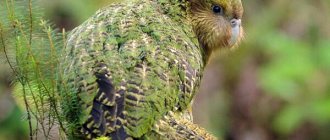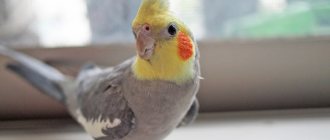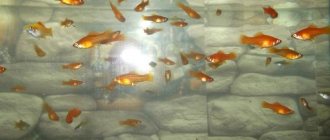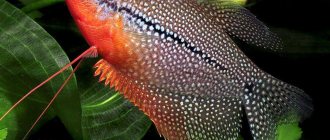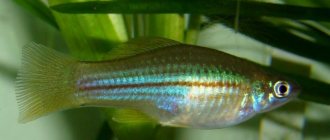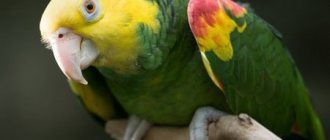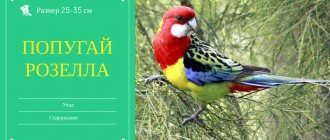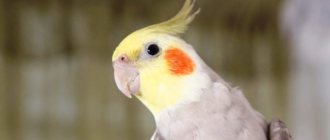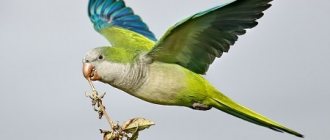- Wild animals
- >>
- Birds
Alexandrian parrots enjoyed the greatest popularity back in the days of Ancient Rome. It was then that it was considered a privilege and a sign of belonging to high society to have an amazing bird as a pet. Today, this type of bird is not so popular, but its mental and intellectual abilities, as well as its learning speed and ability to speak, are truly impressive. The Alexandrian parrot is characterized as a calm, friendly and very sweet bird. Often, when well cared for, they show feelings of affection for their owner.
Origin of the species and description
Photo: Alexandrian parrot
Alexandrine parrots are representatives of chordate birds, classified into the order Psittacidae, the family Psittacidae, the genus of ring-necked parrots, and the species of Alexandrine ring-necked parrot.
The first mention of Alexandrian parrots dates back to the period of Ancient Rome. At that time, representatives of the local nobility kept them as pet birds, kept them in gilded cages, and even often hired teachers to train them. In those distant times, a bird was worth more than a good, strong slave.
Birds were brought to the territory of modern Europe by Alexander the Great in the fourth century. The soldiers of his large army brought the birds to Europe during the period when they were returning from a campaign in Asia. This species of bird was named in honor of Alexander the Great.
The demand and excitement around the amazing birds arose after they managed to save the great warrior and conqueror. There is a story when, during one of the battles, the army of Alexander the Great was almost completely defeated, and the enemies tried to capture the leader himself. However, at his most dangerous moment, several birds broke out of their cages and fearlessly rushed towards the invaders. They, in turn, rushed to catch the birds, but were unable to do so. However, as soon as Alexander the Great called them to return to their cells, they immediately obeyed him.
Ability to speak
Over the course of its long life, Alexander's parrot is able to learn up to 15 words and simple phrases. He can use some of them according to situations. For example, greeting people as they enter. Or say phrases related to food and delicacies.
You can teach your pet to talk from a very early age. Although, you can successfully teach a few words to an adult parrot.
Training methods are common to all parrots - repeating words, playing in a situation, including a second person in the process.
Great Alexandrine parrot talking
Appearance and features
Photo: Bird Alexandrine parrot
The Alexandrian parrot is one of the most striking and largest representatives of the ringed genus. This bird has a rich, grassy green color, which in the back of the head has a beautiful blue tint. The parrot's beak is quite large and curved. In young individuals it is orange, in adults it is a rich, red color.
Video: Alexandrian parrot
There are marks on the body of a different color from the main one - in the area of the shoulder blades there is a brown spot, and in the forehead area there is a dark, almost black mark. A dark stripe runs from the beak area along the lower side of the head to the crown. In males in the second year of life, a so-called necklace appears in the neck area - bright pink on top and dark brown or black on the sides. From this necklace, a dark stripe called a tie runs down the chest.
These birds have a number of distinctive features:
- massive, large beak;
- large head;
- quite large body, the size of which reaches 50-60 centimeters;
- long, straight downward-pointing tail;
- the presence of dark red patches on the wings;
- significant wing span, which reaches 20-22 centimeters.
This species of birds has pronounced sexual dimorphism - the female is smaller in size compared to the males and does not have a bright necklace in the neck area. Ornithologists note that it is the large size and the presence of colored patches on the wings that are considered to be the main distinguishing features of the Alexandrian parrot.
Owner reviews
Weetros
For those who are just thinking about or are already planning to purchase this wonderful bird, I will write a few of the most important points.
Be sure to choose a cage of such size that the bird can fully open its wings in it; under no circumstances choose a round one.
It is important for him to have a place in the room protected from drafts; place the cage at eye level or slightly higher. The cage should contain toys made from natural materials, preferably for large parrots, as the rest are destroyed in an instant. Food for medium-sized parrots, mineral mixture, mineral stone, vegetables, fruits (not everything can be given). Change the water daily.
When you release the bird, so that it does not hit its head on windows and mirrors, they must be closed. The bird chews on everything, from mobile phones to books, literally everything, so you need constant supervision if you don’t want to lose anything valuable or the bird. But, in general, the parrot is beautiful, smart, interesting, curious, and learns a lot of tricks and conversation.
Emilia Korikova
We adopted this parrot in October last year. He was then about 3 months old. The bird is very capricious. We don’t know the gender yet, we think it’s a male. It chews up everything in sight. But we love the bird madly, he is very funny.
Setter
Beautiful parrots, quite intelligent, easily tamed, and well trained. Favorite bird of the Pope. Talking about the difficulty in taming and keeping Alexanders without ever observing them is like talking about art without being able to determine the color. In January we brought the little Alexanders. Some of them are already sitting quietly on the hand, listening to the voice, and eating from the hand.
Video
Where does the Alexandrine parrot live?
Photo: Alexandrian parrot
Alexandrine parrots naturally live mainly in regions of humid forests. The geographical regions of their distribution are very diverse, depending on the subspecies. They prefer to be located at the very top of tropical thickets. They rarely descend to the surface of the earth.
Geographical regions where birds live in natural conditions:
- India;
- Pakistan;
- Afghanistan;
- Iran;
- Madagascar;
- Israel;
- Sri Lanka;
- Andaman Islands;
- Myanmar;
- Vietnam;
- Laos.
Small populations of Alexandrine or necklace parrots can be found in natural conditions in Belgium or Germany. Previously, the islands of Reunion and Rodrigues were inhabited in large numbers. Currently not available in these regions. Alexandria parrots are considered excellent sprinters, but they tend to fly only short distances.
They can often settle in close proximity to agricultural land, which causes significant damage to the crop; they especially like to visit corn fields and feast on juicy cobs. When not flying, they most often hide in the crowns of tall trees. At night they can also be very active and fill the crowns of tall trees with huge flocks, the number of which reaches several hundred, and sometimes thousands or more.
In many countries around the world, this type of parrot lives as pets, or is raised and bred in special nurseries and zoos. They quickly adapt to new living conditions and feel quite comfortable as pets.
Habitat, lifestyle
Ringed parrots live in African and South Asian countries - India, Sri Lanka, Iran, Pakistan, Vietnam, Laos. Geographical areas vary among individual subspecies. Alexander's parrot is a bird that is characterized by living in a flock. Birds bearing the name of the Macedonian king inhabit tropical forests. They prefer the upper tiers of old, hollow trees. They are cautious and know how to protect themselves from poachers.
Alexandrians are hardy, fly well, and therefore can easily cover long distances. However, they usually do not have to make long flights: the natural environment of the tropics is fertile, and there is enough food for everyone. However, birds sometimes fly into maize fields and destroy the unripe crop.
Parrots cause serious damage to the agricultural industry. This is one of the factors in population decline.
What does the Alexandrine parrot eat?
Photo: Alexandrian necklace parrot
When living in natural conditions, necklace birds are quite voracious and completely unpretentious. They feed on almost everything that can be suitable as food for birds. These are cereals, seeds of various types of vegetation, corn, fruits of fruit plants and trees, etc.
If a parrot is kept at home, it needs a varied and balanced diet, as this directly affects the health of the bird. A mandatory component of the daily diet of domesticated birds is balanced mixtures for parrots.
They contain in an optimal ratio grains, vitamin complexes, minerals, and other substances necessary for the full functioning and health of the bird. The daily food intake for one adult bird is 50-60 grams of food.
Mandatory components of the daily diet of poultry:
- carrot;
- zucchini;
- beans;
- beet;
- zucchini;
- cucumbers;
- apples;
- plums;
- oranges;
- apricots;
- seeds;
- soaked white bread;
- fresh greens.
Potatoes, onions and eggplants are strictly prohibited. Millet in spikelets is considered a special delicacy. This delicacy should be given in moderation - no more than two ears of grain per day.
Foods that can harm your parrot's health:
- raw eggs;
- honey;
- sugar;
- products containing chemicals and artificial food additives, dyes.
During the period when birds are molting, you can add several sesame grains to the feed mixture, as well as add vitamin supplements. The owner of the handsome feathered creature must ensure that he always has access to clean drinking water. Parrots enjoy eating homemade porridge: rice, buckwheat, oatmeal, corn, etc. Porridges are prepared in water without adding salt, sugar, flavorings or spices. They must be served freshly prepared, slightly warm.
Features of character and lifestyle
Photo: Alexandrian ring-necked parrot
Alexandria parrots quickly get used to new living conditions and people. To owners who can provide good care and living conditions, they express their affection and affection. Birds have a good-natured, calm and inquisitive character. Scientists and researchers even claim that birds are endowed with intelligence and intelligence. Birds are undemanding and not picky about their living conditions. All they need is a spacious cage, a balanced diet, water treatments, 1.5-2 hours of free flights per day, the attention of the owner, and his love.
Birds are considered excellent singers and have a strong and sonorous voice. I can sing beautiful, lingering trills for a long time. Starting from the age of three months, parrots can be taught to speak. They learn quite easily and can remember a large number of words if they feel comfortable and safe. The fact that the pet has become comfortable and is ready to completely trust its owner is evidenced by its behavior. He gladly accepts food from the hands of his owner, sits on his shoulder, in his arms, does not flinch and is not frightened by third-party rustles.
When living in natural conditions, they spend most of their lives in the treetops of tropical forests. Most often they gather in small flocks of up to ten individuals. Particular sensitivity and emotionality of birds is observed from January to the end of March. Parrots nest during this period of time.
Birds love rain and water treatments. When living in natural conditions, they frolic and play in the rain. Therefore, when kept at home, it is sometimes necessary to create conditions for birds to undergo water procedures.
Keeping at home
Alexandrians know how to keep the house separate from the timbre of his voice. Many people don't like the sound of large birds, but the constant chirping of small birds (such as wavy birds) can also be annoying. Alexander's parrot makes the most unexpected sounds: purrs, whistles, quacks, babbles like a baby.
Attention! Ringed parrots are friendly to people, love attention and affection, but are easy to leave alone. This trait helps to give preference to the Necklace if a person does not need a companion, but a quiet, self-sufficient animal.
Arrangement of the cage
Alexander's parrot is easy to care for and maintain, but a large bird requires a spacious cage, or even better, an aviary. If living conditions allow, it is recommended to give preference to structures of impressive size. Inside you can put homemade perches made from thick unprocessed branches. The Alexandrian parrot has wide feet and long fingers, so the perch should be at least 3 cm in diameter.
List of accessories your feathered pet will need:
Decide how to organize all this taking into account the bird’s convenience. It is advisable to place a stand or secure a bow near the feeder so that the parrot can feed comfortably.
Near the cage or on its roof you can build a children's playground with swings, ladders, and horizontal bars. When the bird is allowed out for a walk, it will enjoy exercising, stretching its muscles and exercising its beak.
Diet
The parrot needs dry food consisting of grains, seeds and nuts. Among factory-produced food products, you can choose what suits us best in terms of price, quality and composition. The Alexandrian parrot is suitable as food for large birds. Thanks to their massive beak, Alexandrians can chew and crush fairly hard ingredients, such as nut shells. Corn is a favorite ingredient, especially when it’s young.
In addition to chopped foods, the diet should include seasonal vegetables, fruits, and berries. They can be served whole or as a salad. Jade parrots are not picky, they love new things with interest. Green leaves are needed in the same way as juicy fruits - they contain vitamins that promote feather growth. The basic diet is supplemented with germination food, treats, mineral and vitamin supplements. Such a full menu helps keep the bird healthy and active, as well as the beauty of its plumage.
Social structure and reproduction
Photo: Alexandrian parrot
The breeding season when living in natural conditions occurs from March to November. During this period, birds form pairs. The male shows incredible care for the female. The female lays from one to four to five eggs. 28-30 days after laying, the chicks are born. Throughout this period, the female incubates the eggs, and the male takes care of her, obtains and brings food.
Chicks are born completely helpless and practically naked. However, they quickly grow stronger and become covered with feathers. The first time babies emerge from their shelter is at 4-5 weeks. The offspring that hatch from the eggs remain in the nest for up to 7-8 weeks. During this entire period, their parents take full care of them. Upon reaching this period, they leave the place of birth and lead an independent lifestyle.
Alexandria parrots reach sexual maturity in a period of 12 months. Individuals aged from one to three years participate in reproduction.
The average life expectancy of this species of birds in natural conditions is 25 years. When living at home and with good care, this figure can double. Breeding Alexandrian parrots at home is an extremely difficult and difficult task, since a pair of birds is selected not by the owner, but by the bird itself. During the breeding season, it is necessary to provide your pets with a balanced, nutritious diet. Lack of the required amount of minerals and vitamins can lead to the death of offspring and their parents.
The second important point when breeding parrots at home is organizing a nesting site. It is best if, on the territory of a spacious cage, the owner organizes a wooden house, the height of the walls of which will be at least 10 centimeters. It is best to cover the bottom of such a house with dried grass or sawdust.
Price
Having decided to get a parrot, you need to take a responsible approach to choosing a store. If possible, it is recommended to involve an experienced specialist or breeder in selecting an individual. Among stores, preference should be given to trusted outlets that have connections with bird lovers' societies.
The price of an Alexandrian parrot directly depends on the age, sex and condition of the bird. A reliable way to distinguish a juvenile from an adult is to look at the eyes. The iris of young representatives of the species is subtle, dark gray. The iris of the eye changes over several months, and is finally formed after 7 months. The minimum price for Alexandrian ringed is 10 thousand rubles.
Natural enemies of Alexandrine parrots
Photo: Bird Alexandrine parrot
When living in natural conditions, birds have quite a lot of enemies.
The main natural enemies of Alexandrian parrots:
- stoats;
- opossums;
- large lizards;
- large feathered predators.
When living in natural conditions, bird nests are often plundered and destroyed by predators, lizards and other representatives of the local flora and fauna.
Humans pose a particular danger to Alexandrian parrots. Local residents and poachers catch them in large quantities for the purpose of obtaining material rewards and trade. Due to the fact that birds are not afraid of people and often exist in large groups, they are easy to catch in large quantities. The habitats of bird populations are often located in close proximity to human settlements.
Many parrots are exterminated by farmers defending their corn plantations and grain fields.
Bird deaths are also common at home and in nurseries. This is due to diseases, poor nutrition, and the presence of drafts, which have a detrimental effect on birds. Poultry also often die from electric shock, traumatic injuries, cuts and injuries, as well as poisoning and flying outside their home.
Lifespan
In the wild, birds live up to 15 years. In captivity, under the right conditions, Alexandrine parrots live up to 30 years or more.
Alexandrian parrot
Factors that affect quality of life:
- proper nutrition;
- timely veterinary care;
- interesting activities, attention from home;
- physical activity;
- marriage partner.

